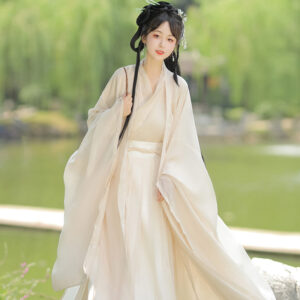
Accessories are an integral part of the traditional Hanfu ensemble, enhancing its elegance and completing the look with cultural significance. These accessories vary based on the wearer’s social status, occasion, and the specific Hanfu style, but they all contribute to the overall harmony and aesthetic of the outfit. Here are some of the most common accessories worn with Hanfu:
1. Hairpins (簪子, Zanzi)
Hairpins were one of the most essential accessories in ancient China, used by both men and women to secure their hair in intricate buns and styles. The materials and designs of hairpins varied according to one’s social status and the occasion.
- Types of Hairpins: Simple wooden or jade hairpins were often worn in everyday life, while gold, silver, or gemstone-encrusted hairpins were reserved for formal events or worn by members of the nobility.
- Cultural Significance: Hairpins also had symbolic meaning in ancient Chinese culture. For example, in a traditional coming-of-age ceremony called Jiji (笄礼), a girl would receive a hairpin to signify her transition into adulthood.
2. Headwear (头饰, Toushi)
Headwear is another important accessory that varies greatly depending on the occasion and the Hanfu style. Both men and women had distinct forms of headwear in different dynasties.
- Fengguan (凤冠, Phoenix Crown): This is an elaborate headdress worn by women, especially empresses or high-ranking noblewomen, during ceremonies such as weddings. It often features a phoenix motif, pearls, and intricate embroidery.
- Guan (冠): For men, the Guan was a formal hat or headpiece worn by scholars and officials. In the Confucian Crowning Ceremony (冠礼), the Guan marked a man’s transition into adulthood.
- Mian (冕): This was the most formal headdress, worn by the emperor and high-ranking nobles during major ceremonies.
3. Belts and Sashes (腰带, Yaodai)
Belts and sashes are commonly worn with Hanfu to cinch the waist and give the outfit shape. These are often elaborately decorated and serve both a functional and ornamental purpose.
- Materials: Silk, brocade, and embroidered fabric belts are popular. In more casual settings, simpler fabric sashes are used, while formal attire may include ornate belts with intricate metal buckles.
- Ornamentation: The belt can also feature tassels, jade pendants, or belt hooks (钩, Gou), which serve as both a decorative and functional way to fasten the belt.
4. Jade Pendants (玉佩, Yupei)
Jade pendants are a significant symbol of wealth, status, and cultural beliefs in China, often worn with Hanfu by both men and women. Jade is believed to bring good luck and protect the wearer from evil.
- Types of Jade Pendants: Jade pendants can range from simple, circular designs to more elaborate carvings of auspicious animals or symbols, such as dragons, phoenixes, or the Ba Gua (eight trigrams of Taoism). The pendants are usually attached to the belt and hang gracefully along the sides of the body.
- Cultural Significance: In ancient China, jade was considered the “stone of heaven” and was a symbol of purity, wisdom, and immortality.
5. Fans (扇子, Shanzi)
Fans are a graceful and functional accessory, used both for cooling in hot weather and as a decorative item to complement the Hanfu.
- Types of Fans:
- Round Fans (团扇, Tuan Shan): Often carried by women, these fans are made of silk or paper, stretched over a round bamboo frame, and usually feature beautiful embroidered or painted designs.
- Folding Fans (折扇, Zhe Shan): Both men and women used folding fans, which could easily be tucked into a sleeve or belt when not in use. Folding fans are often adorned with calligraphy or traditional paintings.
- Cultural Symbolism: Fans were not just for practical use; they symbolized refinement, elegance, and cultural sophistication. In many dynasties, fans were also used as a form of artistic expression, with poets and artists inscribing poems or painting landscapes on the fan surfaces.
6. Handbags and Pouches (荷包, Hebao)
Since Hanfu often lacks pockets, people carried small pouches or embroidered bags tied to their belts to hold personal items like money, cosmetics, or handkerchiefs.
- Materials and Designs: Handbags and pouches were typically made of silk or brocade and adorned with intricate embroidery. Popular designs included flowers, birds, auspicious symbols, and even personal monograms.
- Functionality: These accessories were not only beautiful but also functional, providing a way to carry personal belongings while maintaining the flow and form of the Hanfu.
7. Shoes (鞋子, Xiezi)
Shoes worn with Hanfu were often tailored to match the rest of the outfit, both in style and decoration. In ancient China, shoes reflected social class, with different materials and designs used for commoners and aristocrats.
- Types of Shoes:
- Cloth Shoes: Made of fabric like cotton or silk, these shoes were comfortable and came in various styles, often embroidered with flowers or animals.
- Platform Shoes: For formal occasions or for nobility, platform shoes (花盆底, Huapen Di) were worn to elevate height and status.
- Slippers: These were more casual and commonly worn indoors.
8. Jewelry (首饰, Shoushi)
Jewelry played a key role in complementing Hanfu, particularly in formal settings. Both men and women wore jewelry, but women’s jewelry was typically more elaborate and ornamental.
- Types of Jewelry:
- Necklaces: Necklaces made of pearls, jade, or other precious stones were worn to add an extra touch of elegance.
- Earrings: Earrings varied from simple studs to more complex dangling designs, often featuring gold, jade, or pearls.
- Bracelets and Bangles: Jade bangles were particularly popular among women and were often passed down as family heirlooms.
9. Ribbons and Silk Scarves (丝带, Sidai)
Ribbons and silk scarves were often used as decorative accessories to add a touch of color and sophistication to Hanfu.
- Ribbons: These could be tied around the waist, sleeves, or hair, adding extra movement and grace to the outfit.
- Silk Scarves: In colder weather, silk scarves provided warmth while maintaining the refined elegance of Hanfu.
10. Perfume Pouches (香囊, Xiangnang)
Perfume pouches were small embroidered bags filled with fragrant herbs or spices. These were worn around the neck or attached to the waist and were thought to ward off evil spirits and bring good fortune.
- Designs and Materials: These pouches were made from silk or cotton and decorated with embroidery of auspicious symbols such as cranes, flowers, or Chinese characters for good luck.
- Cultural Meaning: Beyond their fragrant purpose, perfume pouches also served as symbols of affection and love, often given as gifts between lovers.
Conclusion: Complementing Hanfu with Accessories
Accessories are crucial to completing the traditional Hanfu look, adding elegance, symbolism, and practicality. From hairpins and jade pendants to fans and perfume pouches, each accessory serves a unique purpose, enhancing both the aesthetic and cultural richness of the Hanfu ensemble. Wearing these accessories not only reflects the beauty of ancient Chinese fashion but also honors the traditions and values embedded in the Hanfu culture.
Share this post
Recent Posts


What were the key features of Hanfu during the Tang Dynasty?

How did Hanfu styles vary during different Chinese dynasties?

What accessories are typically worn with Hanfu?

How do you choose the right Hanfu for different seasons?

Newsletter
Popular Categories
Related Post
Sed aliquam, tortor et sodales malesuada, lorem leo luctus tellus, quis interdum eros nibh in nunc. Cras dignissim malesuada, lorem leo luctus

What are the winter hanfu called?

What were the key features of Hanfu during the Tang Dynasty?

How did Hanfu styles vary during different Chinese dynasties?


